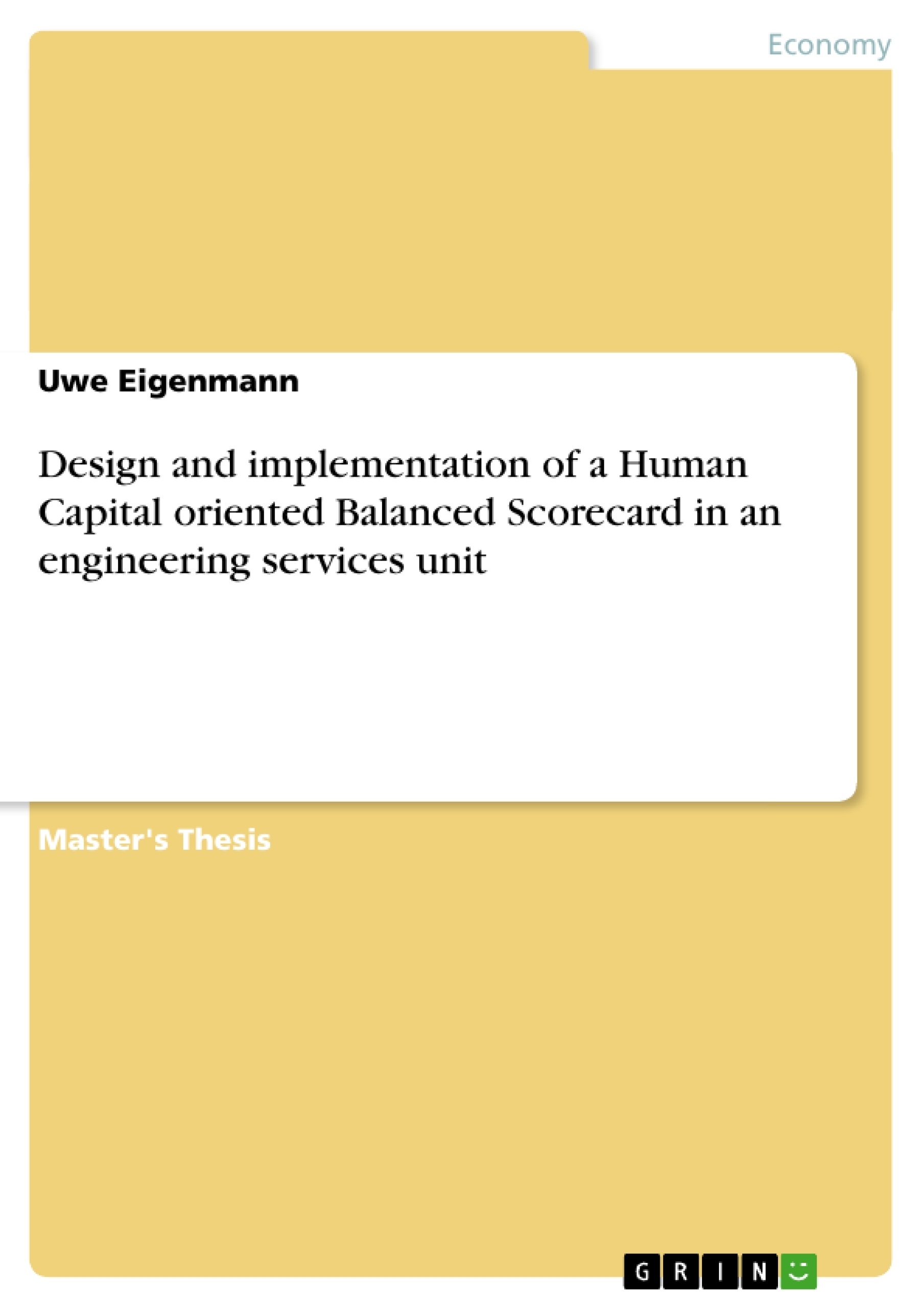Abstract
The utilization of employees often is the only measure for success of engineering services units. The question how many days of paid services can be billed to a customer is so dominant that other aspects are completely neglected. However, focusing on maximizing just one, financial, value – revenue by employee - might not be sufficient to guarantee sustainable success. The aim of this dissertation is to develop a management instrument for an engineering services unit based on the balanced scorecard approach. Even though the value of human capital often receives only little attention, employees are the key differentiator of an enterprise. The knowledge, experience and attitude of people can not easily be copied by competitors. Since human capital’s contribution to business success is difficult to measure, it often plays no role in management systems. This situation can only change if the value of human capital can be determined and represented. The term “human capital” is explained in more detail in the first part of this work. What is human capital and why is it becoming increasingly important? Several approaches to determining human capital are described and analysed.
In the second part of this work, a Balanced Scorecard is developed on a step-by-step basis for an engineering services unit. Particular attention is paid to the human capital aspect. However, the purpose of this work is not to develop a scorecard that serves only to assess and control human capital variables. Examples of such dedicated Balanced Scorecards are the HR-Scorecard and the Human Capital Management Scorecard. However, these Scorecards may complement the traditional Scorecard, but cannot replace it. They are focused on human resource figures only and thus are not linked with other measures, such as financial indicators. The Balanced Scorecard to be developed for the engineering services unit should reflect the strategy of the business unit. The idea is to use this Balanced Scorecard as a management tool in future. Therefore the Balanced Scorecard design will follow the traditional approach but put special emphasis on human capital.
Inhaltsverzeichnis (Table of Contents)
- Introduction
- Definition of Human Capital
- What separates Human Capital from other assets
- Human Capital - the un-word of the year 2004
- The gap between book value and market value
- Human Capital Measurement
- Human Capital Accounting
- Weighted personnel cost method
- Method of future remunerations
- Flamholtz's Approach (Human Resource Accounting)
- Deductive Summarizing Approaches
- Market Value to Book Value
- Tobin's q
- Calculated Intangible Value
- Inductive Analytical Approach
- Intangible Assets Monitor
- Intellectual Capital Navigator
- Balanced Scorecard
- Nomen est Omen
- Perspectives of Balanced Scorecard
- The Financial Perspective
- The Customer Perspective
- The Business Process Perspective
- The Learning and Growth Perspective
- Human-Resource-Scorecard
- Human Capital Management Scorecard
- Human Capital Key Figures
- Economic Value Added and Human Economic Value Added
- Human Capital Value Added and Human Capital Return On Investment
- Human Asset Worth
- Employment Cost
- Individual Asset Multiplier
- Profile of the Business Unit “Engineering Services”
- Design and Implementation of a Balanced Scorcard
- Defining the Vision
- Procedure: A journey into the Future
- Formulating the Vision for the Engineering Services Business Unit
- SWOT-Analysis
- Procedure
- Strengths of the Business Unit
- Weaknesses of the Business Unit
- Opportunities Coming from the Business Unit Environment
- Threats Coming from the Business Unit Environment
- Supplementary Interviews
- Strategy
- Perspectives and Key Figures
- Financial Perspective
- Customer and Partner Perspective
- Process Perspective
- Human Capital Perspective
- Implementing the Balanced Scorecard
- General Conditions
- Communication and Training
- Software Support
- Defining the Vision
- Conclusion
Zielsetzung und Themenschwerpunkte (Objectives and Key Themes)
The dissertation aims to develop a management instrument for an engineering services unit based on the Balanced Scorecard approach. The work emphasizes the importance of human capital, which is often overlooked in traditional financial-driven approaches to business success. The dissertation explores how to measure and manage human capital's contribution to business success, as well as how to integrate human capital into the Balanced Scorecard framework.
- The significance of human capital in the success of engineering services units.
- Methods and challenges associated with measuring human capital.
- The application of the Balanced Scorecard approach to incorporate human capital into management systems.
- The development of a specific Balanced Scorecard for an engineering services unit.
- The importance of implementing the Balanced Scorecard and integrating human capital considerations into strategic decision-making.
Zusammenfassung der Kapitel (Chapter Summaries)
- The introduction establishes the context for the dissertation, highlighting the traditional focus on financial performance and the growing importance of human capital in engineering services units.
- The second chapter provides a thorough definition of human capital, differentiating it from other assets and exploring its increasing relevance in the modern business environment.
- Chapter 3 focuses on various methods of human capital measurement, including accounting approaches, deductive summarizing approaches, and inductive analytical approaches. This chapter examines the strengths and limitations of each approach, with particular emphasis on the Balanced Scorecard.
- Chapter 4 provides a profile of the specific engineering services unit that will be used as a case study for the development and implementation of the Balanced Scorecard.
- Chapter 5 focuses on the design and implementation of the Balanced Scorecard for the engineering services unit. It includes steps such as defining the vision, conducting a SWOT analysis, developing strategies, and defining key figures for each perspective of the Balanced Scorecard.
Schlüsselwörter (Keywords)
The key focus areas of this dissertation include human capital, balanced scorecard, engineering services, intangible assets, management systems, strategic decision-making, performance measurement, and knowledge management.
- Human Capital Accounting
- Quote paper
- Uwe Eigenmann (Author), 2005, Design and implementation of a Human Capital oriented Balanced Scorecard in an engineering services unit, Munich, GRIN Verlag, https://www.grin.com/document/41544



